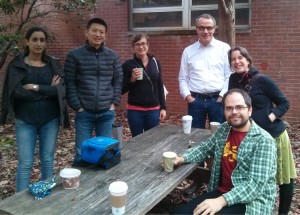Two publications with contributions from the lab were published this week.
1. The first analysis of transcriptomes of pleurocarpous mosses led by Matt Johnson (postdoc with norman Wickett in Chicago) appeared: Johnson M.G., C. Malle, B. Goffinet, A.J. Shaw & N.J. Wickett. 2016. A phylotranscriptomic analysis of gene family expansion and evolution in the largest order of pleurocarpous mosses (Hypnales, Bryophyta). Molecular Phylogenetics and Evolution 98: 29–40. (pdf)
The abstract reads: The pleurocarpous mosses (i.e., Hypnanae) are a species-rich group of land plants comprising about 6,000 species that share the development of female sex organs on short lateral branches, a derived trait within mosses. Many of the families within Hypnales, the largest order of pleurocarpous mosses, trace their origin to a rapid radiation less than 100 million years ago, just after the rise of the angiosperms. As a result, the phylogenetic resolution among families of Hypnales, necessary to test evolutionary hypotheses, has proven difficult using one or few loci. We present the first phylogenetic inference from high-throughput sequence data (transcriptome sequences) for pleurocarpous mosses. To test hypotheses of gene family evolution, we built a species tree of 21 pleurocarpous and six acrocarpous mosses using over one million sites from 659 orthologous genes. We used the species tree to investigate the genomic consequences of the shift to pleurocarpy and to identify whether patterns common to other plant radiations (gene family expansion, whole genome duplication, or changes in the molecular signatures of selection) could be observed. We found that roughly six percent of all gene families have expanded in the pleurocarpous mosses, relative to acrocarpous mosses. These gene families are enriched for several gene ontology (GO) terms, including interaction with other organisms. The increase in copy number coincident with the radiation of Hypnales suggests that a process such as whole genome duplication or a burst of small-scale duplications occurred during the diversification. In over 500 gene families we found evidence of a reduction in purifying selection. These gene families are enriched for several terms in the GO hierarchy related to ‘‘tRNA metabolic process.” Our results reveal candidate genes and pathways that may be associated with the transition to pleurocarpy, illustrating the utility of phylotranscriptomics for the study of molecular evolution in non-model species.
2. Vigalondo B., Y. Liu, I. Draper, F. Lara, R. Garilleti, V. Mazimpaka & B. Goffinet. 2016. Comparing three complete mitochondrial genomes of the moss genus Orthotrichum Hedw. Mitochondrial DNA Part B: Resources 1: 176–178. http://dx.doi.org/10.1080/23802359.2016.1149784.
The abstract reads: Here, we present a comparative analysis of the mitochondrial genome of three representatives of Orthotrichum Hedw (Bryophyta): two populations of O. diaphanum and one of the related species, namely O. macrocephalum. Their mitochondrial genomes share the same gene content and gene order, and are furthermore structurally identical to those of other arthrodontous mosses. The mitogenome of the allopatric samples of O. diaphanum differ in 0.1% of their sequence, with protein coding genes holding five mutations, including two non-synonymous changes. The divergence between the mitogenomes of the two species, O. diaphanum and O. macrocephalum, is 0.4%. Within a broader sampling of the Orthotrichaceae, patterns of genome divergence are consistent with phylogenetic relationships.
 Dinah has been awarded a Summer Undergraduate Research Fellowship from UCONN to pursue her work on Dendriscocaulon and Ricasolia quercizans in North America. She joined our lab in the fall of 2014 and has been pursuing an independent study. She is spending the current semester abroad. Congratulations.
Dinah has been awarded a Summer Undergraduate Research Fellowship from UCONN to pursue her work on Dendriscocaulon and Ricasolia quercizans in North America. She joined our lab in the fall of 2014 and has been pursuing an independent study. She is spending the current semester abroad. Congratulations.